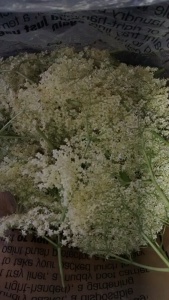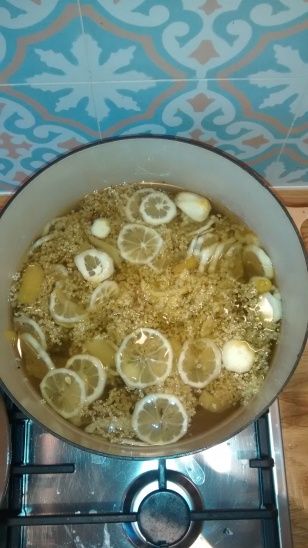What?
If you could gather up quintessential English summers and put them in a bottle, it would taste like elderflower. We love the stuff, and increasingly so. Elderflower cordial is the go to non-alcoholic posh drink used as alternatives to champagne at weddings and taken along to summer dinner parties as something a bit more ‘cool’ than Schloer. And unlike passionfruit juice, which in my opinion is on par with elderflower in yumminess, it thrives in the English climate and is confidently ‘local’.

Picking
When you first begin to forage for elderflower, you start spotting it everywhere and realise that it is particularly good at growing in urban London – all it needs is a little scrap of soil and there it will

be chockablock full of little white flower clouds (unless someone has beaten you to it on the foraging front). It is fairly easy to identify, with some key features being: scraggly scrappy shrub often looking like a tree in London given how tall they grow and clouds of tiny white flowers coming off the branches that smell of elderflower. If a cloud of white flowers is on a stem coming up from the ground, it is not elderflower.
Pick from late May until end of June – so hurry, the window is not massive and now is the time!


What can you do with it?
All green parts are poisonous but the flowers and berries can be used for cordial, jams, champagne, or infused in vinegar, added to chutney, dried and added to cakes and muffins…
Homemade elderflower cordial has become a bit of a summer staple in our household. We make a few batches during the season, which normally lasts us well. Having tried and tested a few recipes, we now use a combination of River Cottage and BBC. You can buy citric acid from chemists; supermarkets don’t stock it (presumably they don’t want people buying in bulk to make drugs).
Ingredients
25 elderflower heads, or as many as you can pick
1kg sugar
zest of 3 lemons and 1 orange, and slices of the remaining fruit
50g citric acid (from chemist)
Method
Remove any bugs from elderflower heads (gently wash if necessary).
Mix sugar with 1.5 litres water and heat without boiling until sugar is dissolved.
Bring mixture to boil and then turn off heat.
Add elderflower heads.
Add zest and slices of lemons and oranges.
Leave for 24 hours.
Line a sieve with a muslin cloth (or thin tea towel). Gradually ladel mixture through cloth into another pan, squeezing out all the juice.
Finally, sterilise a glass bottle by pouring boiling water into it, empty and then pour the cordial into it using a funnel.
Store in fridge for up to 6 weeks.

Verdict
Homemade elderflower cordial is so much tastier than the bought stuff – it is fresher and more pungent and the lemon gives it a good kick. It is really quite easy to make, so it is well worth having a go. One batch should make up a few bottles, and if you don’t think you will drink it quickly enough you can freeze it in ice cube trays which will allow you to see if you will have some left for Christmas!